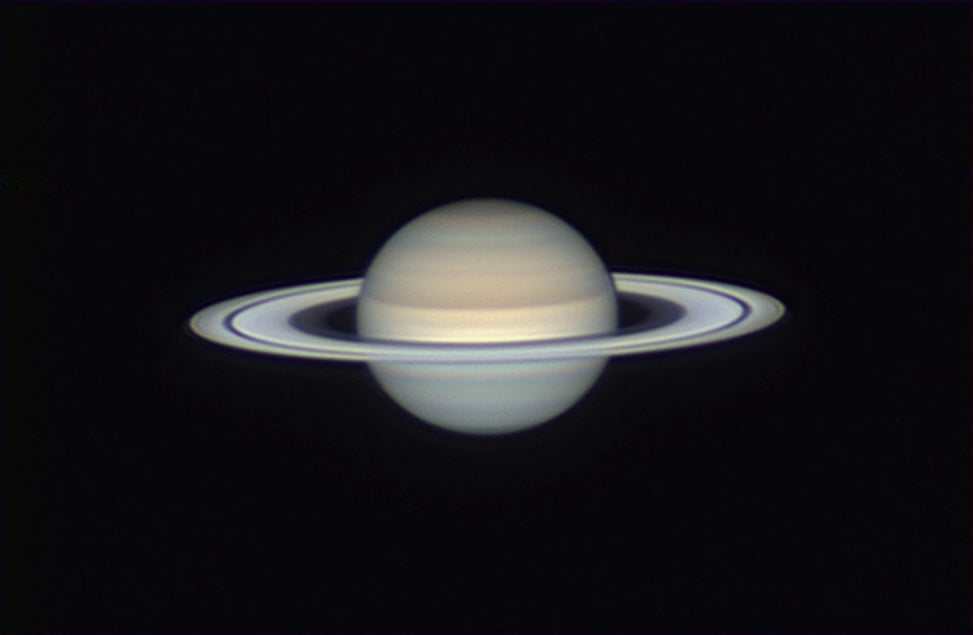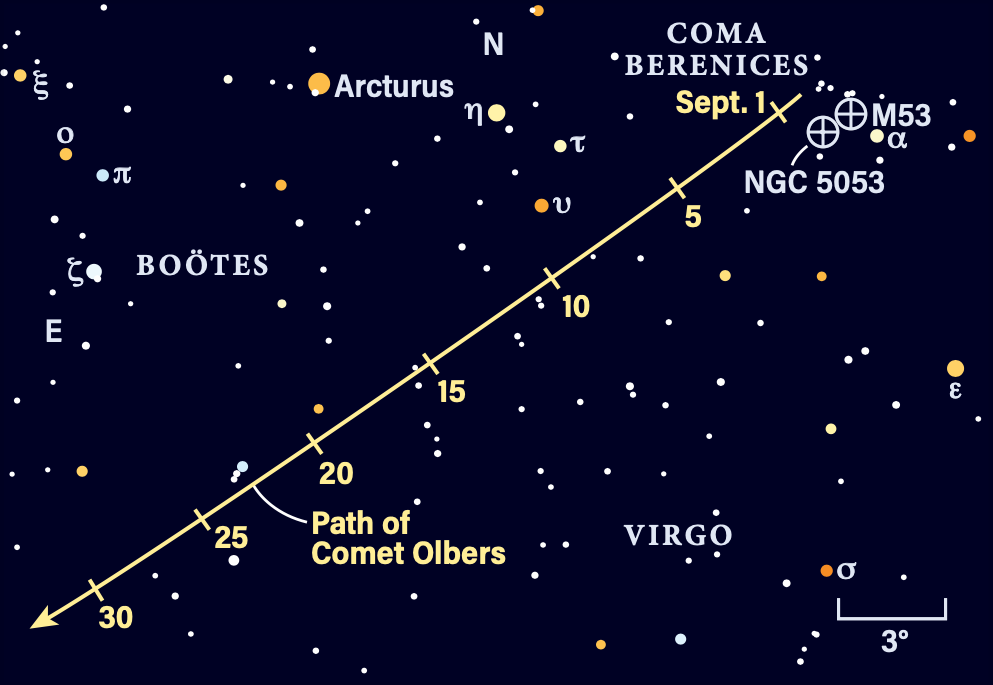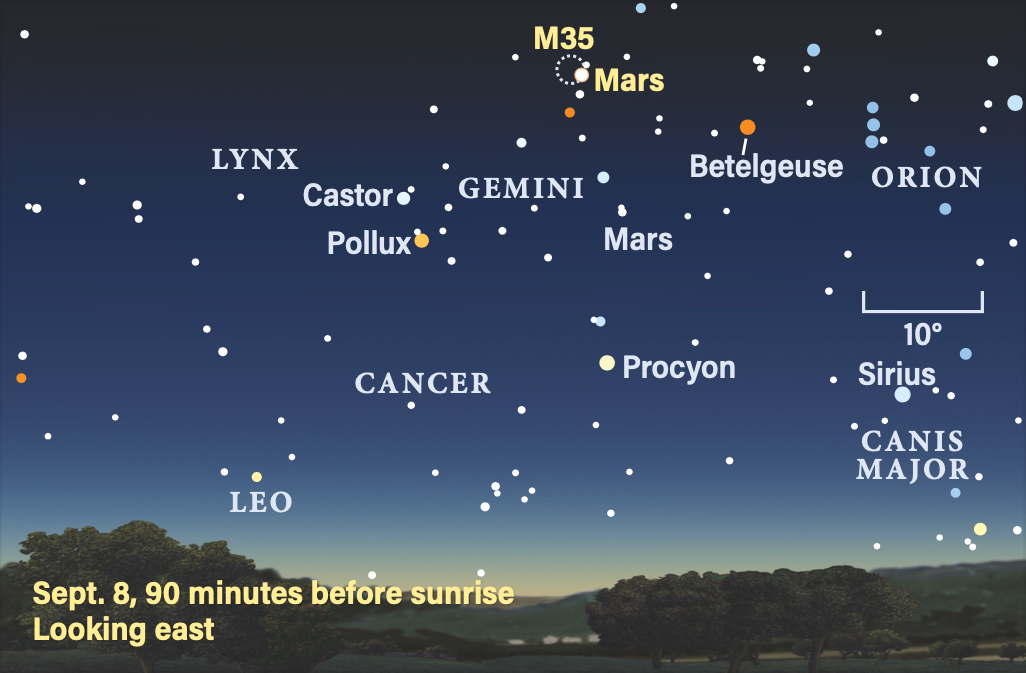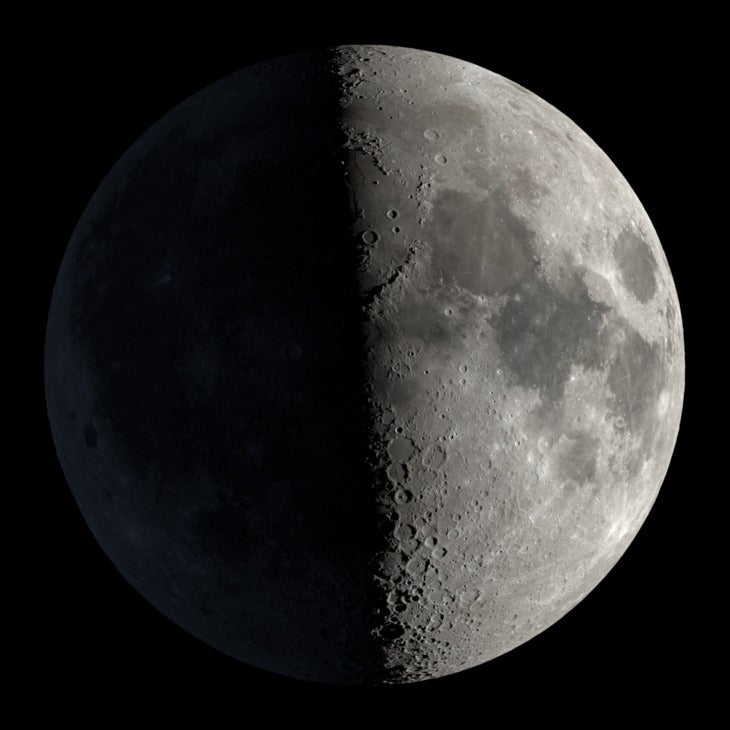
Friday, September 6
The Moon passes 0.5° north of Spica at 1 P.M. EDT, occulting (passing in front of the planet) for some observers in parts of Africa, Canada, and the U.S. To check whether you’re in the path and the timing of the event from various cities, visit the International Occultation Timing Association’s webpage.
The mighty planet Saturn is quickly approaching opposition — we are just two days away! That makes tonight and tomorrow night golden opportunities to watch for a phenomenon called the Seeliger effect, which causes the rings to temporarily brighten. This occurs because as the Sun, Earth, and Saturn line up when the latter is at opposition, the ring particles briefly “hide” their shadows from us, making the rings appear brighter. The rings also get an additional boost from the way sunlight backscatters toward Earth off their component particles.
The Seeliger effect is typically only noticeable for the few days leading up to and following opposition. So, get outside and check out Saturn in your telescope. The planet’s disk now appears 19″ across, with its rings tilted some 3.7° to our line of sight. Those rings stretch 43″ along the long axis, more than twice the diameter of the disk.
Saturn rises in the east around sunset and reaches its highest point in the south around 1 A.M. local daylight time. The ringed planet floats in northeastern Aquarius, south of the Circlet of Pisces. At magnitude 0.5, Saturn outshines all the stars nearby, including magnitude 1.2 Fomalhaut, Piscis Austrinus’ alpha star.
We’ll be back to celebrate the planet at opposition in just two days’ time.
Sunrise: 6:33 A.M.
Sunset: 7:23 P.M.
Moonrise: 9:54 A.M.
Moonset: 8:51 P.M.
Moon Phase: Waxing crescent (11%)
*Times for sunrise, sunset, moonrise, and moonset are given in local time from 40° N 90° W. The Moon’s illumination is given at 12 P.M. local time from the same location.

Saturday, September 7
Now around 8th magnitude, let’s try to catch Comet 13P/Olbers before the Moon gets too bright. Visible in the west after sunset, Olbers remains some 20° high in Boötes an hour after the Sun disappears. The Moon is nearby, at the border of Libra and Virgo, but still a thin enough crescent that it shouldn’t interfere too much.
You’ll find Olbers tonight some 2.5° west-southwest of 4th-magnitude Upsilon (υ) Boötis. For a much brighter jumping-off point, you can also start your search at magnitude 0 Arcturus, Boötes’ alpha star. From here, Olbers is 9.5° southwest.
Olbers now sits near the border of Boötes, Virgo, and Corona Borealis. To the comet’s northwest, you’ll find two globular clusters: magnitude 9.8 NGC 5053 and much brighter magnitude 7.6 M53. Both sit just east of Corona Borealis’ magnitude 4.3 alpha star, Diadem. Compare the shapes and brightness profiles of these globulars with Olbers. And if you’re an imager, take a few exposures — does Olbers still glow green? The carbon emission responsible for this trademark color should be shutting down soon, as the comet grows farther from the Sun. Enjoy the emerald glow while you can!
Sunrise: 6:34 A.M.
Sunset: 7:21 P.M.
Moonrise: 10:54 A.M.
Moonset: 9:14 P.M.
Moon Phase: Waxing crescent (18%)
Sunday, September 8
Saturn officially reaches opposition at 1 A.M. EDT, shining at magnitude 0.5 in Aquarius. It’s also highest in the southern sky for East Coast observers at that time (and it’s highest in the sky for all observers around 1 A.M. local daylight time).
Once again, check out the planet’s gorgeous rings through a telescope to see whether they appear brighter than they did last week (or will in a few days), thanks to the geometry afforded by opposition. Saturn’s brightest moon, Titan, is on display some 2′ west of the planet, while smaller, fainter moons cluster closer to the rings. Iapetus, around 12th magnitude, is nearly 9′ east of Saturn, having recently reached its greatest eastern elongation and now slowly working its way back toward the planet.
Early this morning, Tethys and Rhea lie east of the ringed world; Dione is crossing the planet’s southern polar regions between about 2 A.M. and 4:45 A.M. EDT (note that western time zones may see this event start late on the 7th). The transit will be difficult to observe visually, but high-speed video capture should afford astrophotographers a view. The small moon is barely distinguishable from its shadow, again thanks to the geometry at opposition.
Those observing Saturn this evening will find Titan roughly in the same spot to Saturn’s west, now joined by Tethys, Dione, and Rhea as well.

But Saturn isn’t the only one in the spotlight today. This morning, Mars passes 0.9° due south of the 5th-magnitude open cluster M35 in Gemini, located near the Twins’ feet. Check out the scene in the early-morning sky some 90 minutes before sunrise, when this region is high in the east. Mars’ reddish glow should be easy to spot to the lower left of brighter Jupiter, which still dominates the eastern regions of Taurus the Bull.
Pull out binoculars or a telescope to see the Red Planet standing near a lovely spray of bright stars, spanning some 100′. Under higher magnification, you might also spot the 8th-magnitude open cluster NGC 2158, just southwest of M35.
Sunrise: 6:35 A.M.
Sunset: 7:19 P.M.
Moonrise: 11:57 A.M.
Moonset: 9:42 P.M.
Moon Phase: Waxing crescent (26%)
Monday, September 9
Mercury passes 0.5° north of Leo the Lion’s alpha star, Regulus, at 3 A.M. EDT. Try catching them together just before dawn, reaching nearly 10° high 40 minutes before sunrise.
Mercury is now magnitude –0.7, far outshining the magnitude 1.4 star. The small planet is at its best for the year for those observing in the Northern Hemisphere. Look for them together in the same field of view in binoculars or any telescope. The planet, now roughly 97.6 million miles (157 million kilometers) from Earth, appears to span just 6″ on the sky. It is more than half-lit, with some 64 percent of its face illuminated by the Sun. Although Mercury is brightening, it is also “falling” closer to the Sun, having reached its greatest elongation last week. It will reach superior conjunction at the end of the month, rendering it invisible to us here on Earth; Mercury will reappear in the evening sky by mid-October.
If you’re still enjoying Saturn at opposition — and keeping an eye out for changes in the rings’ brightness as the Seeliger effect fades — be sure to take a look at the gas giant again this evening, when Titan stands just above the ringed planet. It’s crossing from west to east and will appear just a few arcseconds off the northeastern limb by the time darkness falls across most of the U.S. tonight. Those on the East Coast and in the eastern Midwest might catch it standing due north of the planet right around 8:10 P.M. EDT, not long after sunset in the Midwest.
Sunrise: 6:36 A.M.
Sunset: 7:18 P.M.
Moonrise: 1:02 P.M.
Moonset: 10:14 P.M.
Moon Phase: Waxing crescent (35%)
Tuesday, September 10
The Moon passes 0.1° south of Antares at 9 A.M. EDT, though neither is visible at that time. Catch them instead after sunset, as the body and curved tail of Scorpius dominates the southern sky. An hour after sunset in the mid-U.S., Antares and the Moon stand side by side some 20° above the horizon. The Moon is now nearly half-lit; it will reach First Quarter early tomorrow morning. Antares, a bright, 1st-magnitude red giant star, should pop out of the sky quickly as twilight falls. How soon after sunset can you spot it with the naked eye? Does it look orangey-red in color to you?
Just over 1° west of Antares is M4, a bright globular cluster that’s one of the closest such objects to Earth. About 7,200 light-years away, M4 glows at magnitude 5.6 and should be easy to pick up with either binoculars or a telescope. It’s a relatively loosely packed globular, unlike many others, which are highly condensed. Check out the very center of M4, where an elongated bar-shaped structure of stars is visible, spanning about 2.5′. The entire cluster is roughly 36′ across.
Sunrise: 6:37 A.M.
Sunset: 7:16 P.M.
Moonrise: 2:06 P.M.
Moonset: 10:56 P.M.
Moon Phase: Waxing crescent (45%)

Wednesday, September 11
First Quarter Moon occurs at 2:06 A.M. EDT. This phase an excellent time to observe our satellite, as the terminator — the dividing line between night and day — offers an intriguing area where the interplay of light and shadow creates excellent contrast. The terminator also signifies where sunrise is occurring on the Moon, as the lunar day slowly dawns from east to west. Check out the Moon through binoculars or a telescope early this evening and take in the landscape right where the day meets the night, enjoying the long shadows and how they highlight sometimes vast differences in elevation.
Even with minimal magnification, however, you can enjoy some of the Moon’s most notable features: several large, dark splotches now visible on its eastern half. These are seas, or maria, though they were never filled with water — they are ancient, cooled lava basins. The Sea of Crises is particularly noticeable as a nearly perfectly oval-shaped dark spot near the limb. The large, roundish mare to its upper left (northwest on the Moon) is the Sea of Serenity, which appears to flow southeast into the Seas of Tranquillity, Nectar, and Fertility.
Sunrise: 6:38 A.M.
Sunset: 7:14 P.M.
Moonrise: 3:08 P.M.
Moonset: 11:49 P.M.
Moon Phase: Waxing gibbous (55%)
Thursday, September 12
Let’s check out bright Jupiter, standing high in the eastern sky this morning. Now magnitude –2.3, the gas giant lies between the horns of Taurus the Bull, to the lower left of the red giant Aldebaran.
Through a telescope, Jupiter stretches an impressive 40″. Details such as alternating light and dark cloud bands may be visible and the planet’s Earth-sized storm, the Great Red Spot, crosses the middle of the disk around 1:20 A.M. EDT this morning, taking several more hours to rotate toward and then off the eastern limb.
Also visible this morning are all four of Jupiter’s Galilean moons: Ganymede stands alone far to the planet’s east, while Callisto, Europa, and Io lie to the west.
Shortly after midnight in all time zones, Callisto is closest to the planet, slowly moving west. But Io and Europa are jockeying for position, as Io is moving east toward the planet, while Europa is pulling away to the west. Io passes north of Europa at about 4:20 A.M. EDT this morning; after this time, Io is closer to the planet than Europa.
Observers in the western two-thirds of the U.S. will also see Io trade places with Callisto, as the former passes north of the latter around 5:40 A.M. CDT, right around the time the Sun is rising for those in the Eastern time zone. Observers able to keep following the moons’ progress will note Io continuing toward Jupiter, now closest on the western side, while Callisto (closer) and Europa (farther) both move away to the west.
Sunrise: 6:38 A.M.
Sunset: 7:13 P.M.
Moonrise: 4:05 P.M.
Moonset: —
Moon Phase: Waxing gibbous (65%)
Friday, September 13
The circumpolar constellation Cepheus is already high in the north after sunset, swinging in an arc up and around the North Star. This house-shaped star pattern contains a very special star: Delta (δ) Cephei, the original so-called Cepheid variable.
Cepheid variables are particularly important stars because they allow astronomers to measure distances. In the early 1900s, Henrietta Swan Leavitt discovered that their period — the time between subsequent peaks and troughs in brightness — is related to their intrinsic brightness. This means if an astronomer can measure a Cepheid’s period, they can also determine how bright the star truly is and then compare it to how bright the star appears, which is a result of distance — allowing them to work out said distance. It is just such a star that later allowed Edwin Hubble to measure the distance to the Andromeda Galaxy, showing that it was far outside the Milky Way.
Delta Cephei is the first known such star, discovered as variable by astronomer John Goodricke in 1784. Its brightness changes from magnitude 3.6 to 4.3, completing one cycle (from bright to faint to bright again) every 5.366 days. To find Delta, first locate the lower lefthand corner of the “house” shape of Cepheus — note that early this evening, that house appears upside-down, so the corner in question is in the upper right. That star is magnitude 3.4 Zeta (ζ) Cephei. From there, Delta lies just 2.5° northeast. If your eyes are sharp, compare it to nearby Zeta. Is it roughly as bright as its neighbor, or fainter? This should give you a clue as to the part of its cycle it’s in — especially if you come back every day for a few days to watch it fade or brighten.
Sunrise: 6:39 A.M.
Sunset: 7:11 P.M.
Moonrise: 4:53 P.M.
Moonset: 12:51 A.M.
Moon Phase: Waxing gibbous (75%)

Sky This Week is brought to you in part by Celestron.









